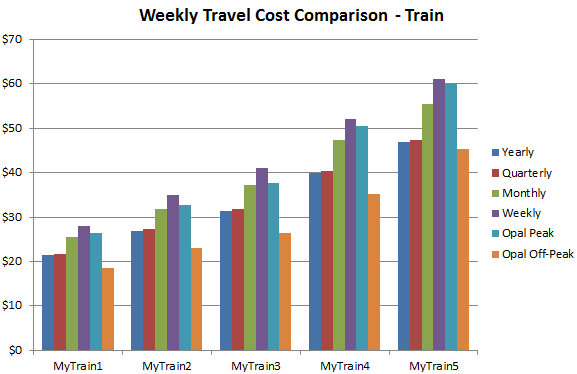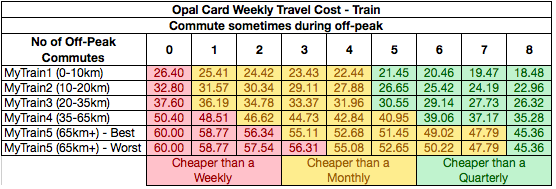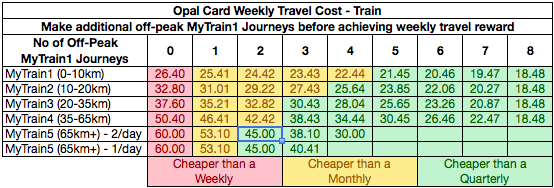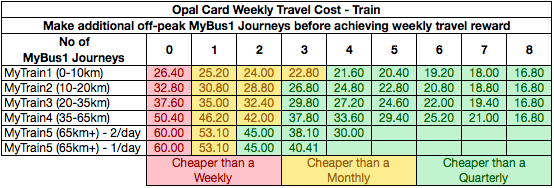A summary of the Opal fare structure, how it compares to paper tickets, and how to minimise your travel costs.
Update 27/12/2015: This post was originally written in March 2014, when the Opal card was brand new, and you still had a choice to use paper tickets if you wanted to. Fast forward to December 2015, and it’s largely defunct:
- I left Sydney shortly after I wrote this post, so I haven’t had any motivation to update it.
- Most Sydney commuters now use an Opal card and soon won’t have a choice - all paper tickets except singles and returns are withdrawn from 1 January 2016.
- Most commuters now know about the free travel hack - and this loophole is likely to be closed in July 2016.
I’m keeping it here for historical value, but merged the original four posts into one so it doesn’t clutter up my blog so much.
1. Fare structure in a nutshell
This section provides a summary of the Opal card fare structure, and the fare incentives and penalties - i.e. the weekly travel reward, off-peak discount, 60-minute transfer, daily fare cap, and default fare.
Where you can use it
You can currently use an Opal card on:
- Trains in Northern and Western Sydney (see opal card website for maps)
- Bus routes 594-594H, 333
- All Ferries
By the end of 2014, you will be able to travel using an Opal card on all trains, buses, and ferries in Sydney, the Blue Mountains, Central Coast, Hunter, Illawarra and Southern Highlands.
Fare Structure
The Opal card fare structure differs to the existing paper single tickets as follows:
- Opal fares are cheaper than paper tickets - train is 50c less, bus is 10-20c less, ferry is 40c less.
- Off-peak fares are available for single train trips.
- Bus fares are based on straight-line distance, not distance traveled. This means that your bus trip may fall under a different fare band when using an Opal card.
2014 Ticket Prices ($)
| Fare | Distance | Paper Single | Opal Peak | Opal Off-Peak |
|---|---|---|---|---|
| MyTrain1 | 0 - 10km | 3.80 | 3.30 | 2.31 |
| MyTrain2 | 10 - 20km | 4.60 | 4.10 | 2.87 |
| MyTrain3 | 20 - 35km | 5.20 | 4.70 | 3.29 |
| MyTrain4 | 35 - 65km | 6.80 | 6.30 | 4.41 |
| MyTrain5 | more than 65km | 8.60 | 8.10 | 5.67 |
| MyBus1 | 0 - 3km | 2.30 | 2.10 | |
| MyBus2 | 3 - 8km | 3.70 | 3.50 | |
| MyBus3 | more than 8km | 4.60 | 4.50 | |
| MyFerry1 | 0 - 9km | 6.00 | 5.60 | |
| MyFerry2 | more than 9km | 7.40 | 7.00 |
Incentives and Penalties
Off-peak discount: Train trips receive a 30% discount if you tap on outside of peak hours - 7am-9am and 4pm-6:30pm weekdays. There is no off-peak discount on bus or ferry trips.
60 Minute Transfer: Each time you tap on and tap off counts as one trip. Any trips which are less than 60 minutes apart (tap off then tap on again within 60 minutes) will be counted as one journey. If both trips are on the same mode of transport you will be charged one fare based on the start and finish points of your journey; if you change modes you will pay the full fare for both trips.
Daily fare cap: Fares are capped at $15/day on Monday-Saturday, $2.50/day on Sunday.
Weekly Travel Reward: After making eight paid journeys in a week (Monday-Sunday), all subsequent journeys for the rest of that week are free.
As a result, if you make 10 journeys per week, travelling with an Opal card will always cost less than a paper weekly or travelten ticket.
Journeys do not count towards the weekly travel reward if they are:
- Free (made after reaching the daily fare cap)
- Default fares
NB eight paid journeys may comprise more than eight paid trips if there were transfers involved.
Default Fare: If you forget to tap on/off you’ll be charged a default fare based on the maximum distance you could have traveled. Default fares will not cause you to exceed the daily fare cap.
Periodical tickets: Existing periodical tickets (i.e. yearly, quarterly, monthly, fortnightly, weekly) are likely to be discontinued once the Opal card rollout is complete.
2. Weekly Travel Cost Comparison
In this section I have calculated the weekly travel cost of using an Opal card, and compared this to the equivalent weekly travel cost of using the various existing periodical paper tickets.
In summary:
If you currently buy:
|
An Opal card will cost you less |
|
An Opal card will cost you slightly more if you always travel during peak. For MyTrain1/2/3 fares the difference is negligible.An Opal card will cost you less if you travel during off-peak at least once per week. |
|
An Opal card will cost you more if you always travel during peak.An Opal card may cost you less depending how many of your first 8 journeys each week are made during off peak. |
Read on if you want to see all of the tables, figures, and graphs…
If you want to work out exactly how much it will cost you to use an Opal card based on your travel requirements, please use the Opal card weekly travel cost calculator.
Ticket Prices
The following table summarises the cost of every kind of ticket that can currently be purchased, vs equivalent opal card fares. NB:
- A fortnightly train ticket is always exactly twice the cost of a weekly ticket.
- For bus and ferry, a TravelTen is considered to be a weekly ticket.
| 2014 Ticket Prices ($) | ||||||||||
|---|---|---|---|---|---|---|---|---|---|---|
| Paper Tickets | Opal Card | |||||||||
| Fare | Dist. | Yrly | Qtrly | Mthly | Wkly | Rtn | OP Rtn | Single | Peak | OP |
| MyTrain1 | 0-10km | 1,120 | 280 | 102 | 28 | 7.60 | 5.00 | 3.80 | 3.30 | 2.31 |
| MyTrain2 | 10-20km | 1,400 | 350 | 127 | 35 | 9.20 | 6.20 | 4.60 | 4.10 | 2.87 |
| MyTrain3 | 20-35km | 1,640 | 410 | 149 | 41 | 10.40 | 7.00 | 5.20 | 4.70 | 3.29 |
| MyTrain4 | 35-65km | 2,080 | 520 | 189 | 52 | 13.60 | 9.20 | 6.80 | 6.30 | 4.41 |
| MyTrain5 | 65km+ | 2,440 | 610 | 222 | 61 | 17.20 | 11.80 | 8.60 | 8.10 | 5.67 |
| MyBus1 | 0-3km | 18.40 | 2.30 | 2.10 | ||||||
| MyBus2 | 3-8km | 29.60 | 3.70 | 3.50 | ||||||
| MyBus3 | 8km+ | 36.80 | 4.60 | 4.50 | ||||||
| MyFerry1 | 0-9km | 48.00 | 12.00 | 6.00 | 5.60 | |||||
| MyFerry2 | 9km+ | 59.20 | 14.80 | 7.40 | 7.00 | |||||
| MyMulti1 | 1,748 | 484 | 175 | 46 | ||||||
| MyMulti2 | 2,052 | 567 | 206 | 54 | ||||||
| MyMulti3 | 2,444 | 676 | 246 | 63 | 23.00 | |||||
Source: IPART Compliance Statement
Weekly Travel Cost Comparison
The following table shows your weekly travel cost using all of the various ticket types currently available, compared to an Opal card.
Assumptions:
- You make 2 trips per day, 10 trips per week.
- With an Opal card, you always achieve the weekly travel reward, and don’t incur any default fares.
- With a periodical ticket, you travel every week that the ticket is valid for.
| 2014 Weekly Travel Cost ($) | ||||||||||
|---|---|---|---|---|---|---|---|---|---|---|
| Paper Tickets | Opal Card | |||||||||
| Yrly | Qtrly | Mthly | Wkly | Return | OP Rtn | Single | Peak | Off-Peak | ||
| No of Days | 365 | 90 | 28 | 7 | 1 | 1 | ||||
| No of Weeks | 52.14 | 12.86 | 4 | 1 | 0.2 | 0.2 | 0.1 | 0.125 | 0.125 | |
| MyTrain1 | 0-10km | 21.48 | 21.78 | 25.50 | 28.00 | 38.00 | 25.00 | 38.00 | 26.40 | 18.48 |
| MyTrain2 | 10-20km | 26.85 | 27.22 | 31.75 | 35.00 | 46.00 | 31.00 | 46.00 | 32.80 | 22.96 |
| MyTrain3 | 20-35km | 31.45 | 31.89 | 37.25 | 41.00 | 52.00 | 35.00 | 52.00 | 37.60 | 26.32 |
| MyTrain4 | 35-65km | 39.89 | 40.44 | 47.25 | 52.00 | 68.00 | 46.00 | 68.00 | 50.40 | 35.28 |
| MyTrain5 | 65km+ | 46.79 | 47.44 | 55.50 | 61.00 | 86.00 | 59.00 | 86.00 | 60.001 | 45.36 |
| MyBus1 | 0-3km | 18.40 | 23.00 | 16.80 | ||||||
| MyBus2 | 3-8km | 29.60 | 37.00 | 28.00 | ||||||
| MyBus3 | 8km+ | 36.80 | 46.00 | 36.00 | ||||||
| MyFerry1 | 0-9km | 48.00 | 60.00 | 60.00 | 44.80 | |||||
| MyFerry2 | 9km+ | 59.20 | 74.00 | 74.00 | 52.002 | |||||
| MyMulti1 | 33.52 | 37.64 | 43.75 | 46.00 | ||||||
| MyMulti2 | 39.35 | 44.10 | 51.50 | 54.00 | ||||||
| MyMulti3 | 46.87 | 52.58 | 61.50 | 63.00 | ||||||
- May be more than $60 if you don’t hit the $15 daily fare cap every day for the first 4 days.
- If you make 8 paid ferry trips your weekly travel cost is capped at $52 until 29 June 2014.
For the more visually inclined readers:

The following tables show the cost difference between using an Opal card vs paper tickets, assuming all train travel is during peak. Green numbers means Opal card is cheaper, red numbers means Opal card is more expensive.
| 2014 Opal Card Weekly Travel Cost Compared to Paper Tickets ($) | |||||||
|---|---|---|---|---|---|---|---|
| Yrly | Qtrly | Mthly | Wkly | Return | OP Rtn | Single | |
| MyTrain1 (0-10km) | 4.92 | 4.62 | 0.90 | -1.60 | -11.60 | 1.40 | -11.60 |
| MyTrain2 (10-20km) | 5.95 | 5.58 | 1.05 | -2.20 | -13.20 | 1.80 | -13.20 |
| MyTrain3 (20-35km) | 6.15 | 5.71 | 0.35 | -3.40 | -14.40 | 2.60 | -14.40 |
| MyTrain4 (35-65km) | 10.51 | 9.96 | 3.15 | -1.60 | -17.60 | 4.40 | -17.60 |
| MyTrain5 (65km+) | 13.21 | 12.56 | 4.50 | -1.00 | -26.00 | 1.00 | -26.00 |
| MyBus1 (0-3km) | -1.60 | -6.20 | |||||
| MyBus2 (3-8km) | -1.60 | -9.00 | |||||
| MyBus3 (8km+) | -0.80 | -10.00 | |||||
| MyFerry1 (0-9km) | -3.20 | -15.20 | -15.20 | ||||
| MyFerry2 (9km+) | -3.20 | -18.00 | -18.00 | ||||
| 2014 Opal Card Weekly Travel Cost Compared to Paper Tickets (%) | |||||||
|---|---|---|---|---|---|---|---|
| Yrly | Qtrly | Mthly | Wkly | Return | OP Rtn | Single | |
| MyTrain1 (0-10km) | 23% | 21% | 4% | -6% | -31% | 6% | -31% |
| MyTrain2 (10-20km) | 22% | 20% | 3% | -6% | -29% | 6% | -29% |
| MyTrain3 (20-35km) | 20% | 18% | 1% | -8% | -28% | 7% | -28% |
| MyTrain4 (35-65km) | 26% | 25% | 7% | -3% | -26% | 10% | -26% |
| MyTrain5 (65km+) | 28% | 26% | 8% | -2% | -30% | 2% | -30% |
| MyBus1 (0-3km) | -9% | -27% | |||||
| MyBus2 (3-8km) | -5% | -24% | |||||
| MyBus3 (8km+) | -2% | -22% | |||||
| MyFerry1 (0-9km) | -7% | -25% | -25% | ||||
| MyFerry2 (9km+) | -5% | -24% | -24% | ||||
3. Weekly Travel Cost Calculator
This is a spreadsheet that allows you to calculate how much it would cost you each week to travel with an Opal card, and compare this to the cost of using the existing paper tickets.
Get it here:
Opal Card Fare Calculator 2014
4. Reducing your travel costs
In previous posts we established that using an Opal card may be cheaper than the existing monthly, quarterly, or yearly tickets - depending on how often you travel during off-peak. In this post I will discuss some strategies to reduce your travel costs, and exactly what you need to do for Opal card to cost you less than the periodical ticket you currently buy.
Strategies to reduce your weekly travel cost
You can exploit the weekly travel reward and daily fare cap incentives to reduce your weekly travel costs. The basic aim is to make your first 8 journeys of the week as cheaply as possible, either by commuting during off-peak or making additional short/off-peak trips during the day.
- Commute during off-peak as often as possible. This is only possible if you commute by train, as there is no off-peak discount for bus or ferry journeys. This strategy is relevant you have a job where your hours are flexible, or your hours are “flexible” - i.e. you work a lot of overtime.
- Make short additional train journeys during the day. For example - if you work near Wynyard, take a train to Town Hall and have lunch at one of the many food courts nearby, then either take the train or walk back (good exercise). This strategy is probably only practical if you work in the city. NB if you make a return train trip within 60 minutes of the first trip, then it only counts as one journey towards your weekly travel reward.
- Make short additional bus journeys during the day. This strategy is currently only practical if you happen to work near one of the bus routes that accepts Opal card, however will become much easier when Opal card is accepted on all buses.
If you want to work out exactly how much you could reduce your travel costs, please use the Opal card weekly travel cost calculator.
Notes:
- These strategies would be most effective if your normal commute is a MyTrain5 fare or a MyFerry2 fare.
- If your normal commute is a MyBus1 your weekly travel cost is already the lowest possible, so you have nothing to gain from these strategies.
- Journeys have to incur a fare for them to count towards your weekly travel reward - so if you manage to hit the daily fare cap, then any subsequent journeys will not count.
Analysis for Train commuters
The following tables are only applicable to train commuters. (Tables for bus and ferry commuters are coming soon.)
Notes:
- Because of the daily fare cap, the weekly travel cost for MyTrain5 depends on which days the off-peak / short journeys are made on - hence there are separate rows for best case and worst case weekly travel cost.
Commuting sometimes during off-peak
The following table shows how your weekly travel cost compares to weekly, monthly, and quarterly paper tickets depending on how many of your first 8 commutes each week are made during off-peak.

The following table shows how many of your first 8 commutes each week need to be made during off-peak in order for Opal card to break even with yearly, quarterly, and monthly tickets.
| No of off-peak journeys required for Opal card to break even | |||
|---|---|---|---|
| Commute sometimes during off-peak | |||
| Paper Ticket Type | Yearly | Quarterly | Monthly |
| MyTrain1 (0-10km) | 5.0 | 4.7 | 0.9 |
| MyTrain2 (10-20km) | 4.8 | 4.5 | 0.9 |
| MyTrain3 (20-35km) | 4.4 | 4.1 | 0.2 |
| MyTrain4 (35-65km) | 5.6 | 5.3 | 1.7 |
| MyTrain5 (65km+) - Best | 7.2 | 6.9 | 2.5 |
| MyTrain5 (65km+) - Worst | 7.2 | 6.9 | 2.5 |
Making additional short train trips
The following table shows how your weekly travel cost compares to weekly, monthly, and quarterly paper tickets depending on how many of your first 8 journeys each week are off-peak MyTrain1 journeys made in addition to your normal commutes.

The following table shows how many of your first 8 journeys each week need to be off-peak MyTrain1 fares in order for Opal card to break even with yearly, quarterly, and monthly tickets.
| No of off-peak MyTrain1 journeys required for Opal card to break even | |||
|---|---|---|---|
| Make additional off-peak MyTrain1 Journeys before achieving weekly travel reward | |||
| Paper Ticket Type | Yearly | QUARTERLY | MONTHLY |
| MyTrain1 (0-10km) | 5.0 | 4.7 | 0.9 |
| MyTrain2 (10-20km) | 3.3 | 3.1 | 0.6 |
| MyTrain3 (20-35km) | 2.6 | 2.4 | 0.1 |
| MyTrain4 (35-65km) | 2.6 | 2.5 | 0.8 |
| MyTrain5 (65km+) | 1.8 | 1.7 | 0.6 |
Making additional short bus trips
The following table shows how your weekly travel cost compares to weekly, monthly, and quarterly paper tickets depending on how many of your first 8 journeys each week are MyBus1 journeys made in addition to your normal commutes.

The following table shows how many of your first 8 journeys each week need to be MyBus1 fares in order for Opal card to break even with yearly, quarterly, and monthly tickets.
| No of off-peak MyTrain1 journeys required for Opal card to break even | |||
|---|---|---|---|
| Make additional off-peak MyBus1 Journeys before achieving weekly travel reward | |||
| Paper Ticket Type | YEARLY | QUARTERLY | MONTHLY |
| MyTrain1 (0-10km) | 4.1 | 3.9 | 0.7 |
| MyTrain2 (10-20km) | 3.0 | 2.8 | 0.5 |
| MyTrain3 (20-35km) | 2.4 | 2.2 | 0.1 |
| MyTrain4 (35-65km) | 2.5 | 2.4 | 0.8 |
| MyTrain5 (65km+) | 1.8 | 1.7 | 0.6 |